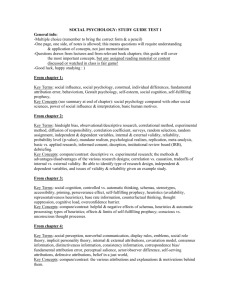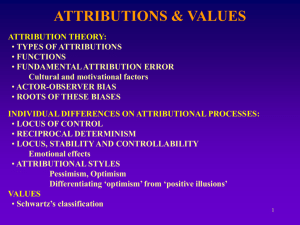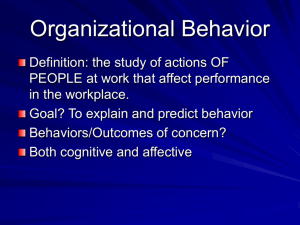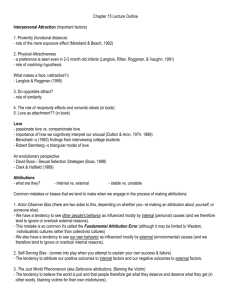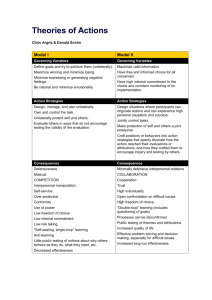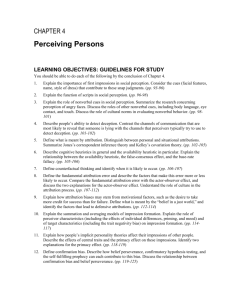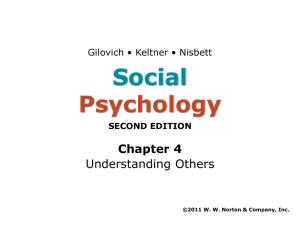Attribution Theory
advertisement
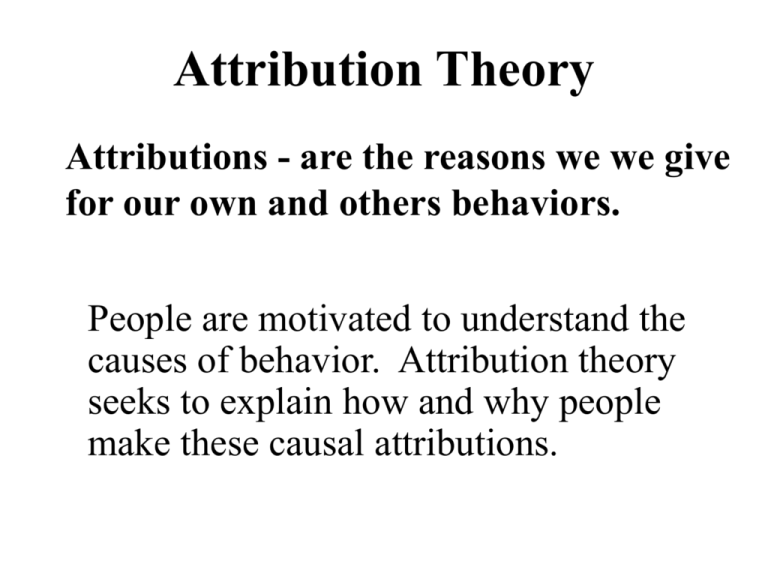
Attribution Theory Attributions - are the reasons we we give for our own and others behaviors. People are motivated to understand the causes of behavior. Attribution theory seeks to explain how and why people make these causal attributions. Why is this baby smiling? • Fritz Heider argued that there are two general types of attributions that people make: –Personal attributions –Situational attributions Personal attributions • Explanations in terms of personal characteristics. For example: – “The baby must be a happy baby.” • Other examples: – “He scored well on the exam because he is smart.” – “She tripped because she is clumsy.” Situational attributions • Explanations in terms of situational factors. For example: – “Someone must have just played with the baby .” • Other examples: – “He scored well because it was an easy test.” – “She tripped because a squirrel ran in front of her.” The Fundamental Attributon Error is that we overestimate the power of the person and underestimate the power of the situation. The availability heuristic partly explains why this error occurs. Why do people make the fundamental attribution error? • The situation is not salient when people make attributions for the behavior of others, but the situation is salient when making attributions for one’s own behavior. • Thus, people are more inclined to take the situation into account when explaining their own behavior. Self-serving bias • People do not make objective situational / personal attributions for their own behavior, though. • They tend to attribute their successes to dispositional factors, and their failures to situational factors. • For example: “I did well on the test because I am smart,” or “I did poor on the test because I didn’t get enough sleep. How do people make attributions? • Kelley argued that people take three factors into account when making a personal vs. situational attribution: – Consistency: Is the baby always smiling? – Distinctiveness: Are there occasions on which the baby doesn’t smile? – Consensus: Do all babies smile? • If consistency is high, and distinctiveness / consensus are low, then a personal attribution is more likely: – “The baby is always smiling, never displays other emotions (like crying), and this is not typical of babies in general. Therefore, this baby must have a happy disposition.” • If consistency is high, and distinctiveness / consensus are also high, then a situational attribution is more likely. – “The baby is always smiling when tickled, but displays different emotions in other circumstances. Smiling when tickled is typical of all babies. Therefore, this baby is smiling because it was tickled” Example • A researcher assigned participants to read out loud either a pro-Castro essay or an anti-Castro essay. A group of listeners rated the extent to which the reader held pro-Castro or anti-Castro beliefs. • Even though the listeners knew that the readers had no choice in which essay to read, the raters judged the pro-Castro readers as being more pro-Castro than the anti-Castro readers. • The listeners failed to take into account the strong situational factor present (that the readers had no choice about which essay to read). Choice leads to stronger attributions of liking. Cognitive dissonance theory •People strive for consistency in their thoughts. •Seems simple, but this idea lead to very counter-intuitive findings. •Festinger and Carlsmith had participants complete a very boring task (turning screws ¼ turn at a time, for a long time). One group was paid $1 to do this, and a separate group was paid $20. Which group should like the task more? Result: • Participants paid $1 enjoyed the task more than participants paid $20. The $20 group had consistent cognitions (“This is stupid, but I’m being compensated for doing it.”). The $1 group had inconsistent cognitions (“This is stupid, and I have no reason to do it.”). • Participants in the $1 group resolved the dissonance by changing their attitude about the task (“I’m not being adequately compensated for this, but that’s OK. This is actually fun!”). Self-perception theory • Bem suggested that another way to think about this research is in terms of attribution. • All participants observed their behavior (doing the boring task) and made a causal attribution for their own behavior. Participants in the $20 group observed their own behavior and thought (“I’m doing this task because I’m getting paid.”). Participants in the $1 group observed their own behavior and thought (“I’m doing this task because I must enjoy it.”). "By altering actors and observers perspectives through videotape replays, mirrors, or other methods, one can correspondingly alter the actors' and observers' causal assessments." - Human Inference Nisbett & Ross 1980


